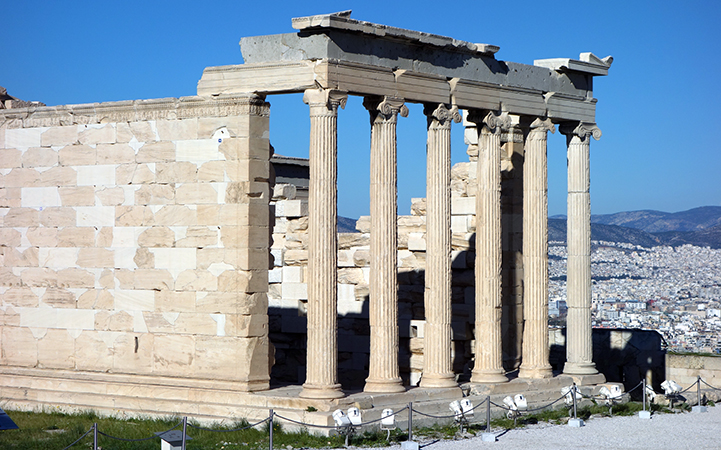Greek Architectural Order: Ever wondered how those epic ancient Greek buildings got their distinct looks? It all comes down to the three main orders: Doric, Ionic, and Corinthian. Each boasts unique columns, capitals, and overall styles that tell a story of evolving aesthetics and engineering prowess across centuries. This exploration dives into the history, characteristics, and lasting impact of these iconic architectural styles, revealing the genius behind the grandeur.
We’ll journey from the sturdy simplicity of the Doric order, found in temples like the Parthenon, to the elegant scrolls of the Ionic order, showcased in the Erechtheion. Finally, we’ll reach the ornate extravagance of the Corinthian order, evident in later Roman structures. Prepare to be amazed by the evolution of these orders and their enduring influence on architecture worldwide!
Greek Architectural Orders
Ancient Greek architecture, renowned for its elegance and enduring influence, is defined by its distinct orders: Doric, Ionic, and Corinthian. These systems, encompassing columns, capitals, and entablatures, represent not just stylistic choices but also a reflection of evolving societal values and technological advancements across different periods of Greek history. This exploration delves into the characteristics, historical context, and lasting impact of each order.
Introduction to Greek Architectural Orders
Source: kastatic.org
The development of Greek architectural orders spanned centuries, reflecting the cultural and technological shifts within ancient Greek civilization. The earliest, the Doric order, emerged in the Archaic period (circa 800-480 BCE), characterized by its simplicity and strength. The Ionic order, appearing slightly later, introduced greater elegance and sophistication, marked by its distinctive volutes. Finally, the Corinthian order, the most ornate of the three, developed during the Hellenistic period (circa 323-146 BCE), showcasing a more elaborate and decorative style.
This evolution mirrored the broader societal changes and artistic expressions of the time.
The Doric Order
The Doric order is characterized by its robust simplicity. The Doric column, typically unbased (lacking a distinct base), features a sturdy shaft that gradually tapers towards the top, culminating in a simple, cushion-like capital. Its proportions emphasize strength and stability. Famous examples include the Parthenon in Athens and the Temple of Hephaestus, both showcasing the order’s enduring power and visual impact.
Compared to the Ionic and Corinthian orders, the Doric order appears more austere and masculine. Its lack of elaborate ornamentation and its emphasis on straightforward proportions distinguish it from the more decorative styles of the later orders. The Doric order’s visual impact is one of powerful simplicity and timeless elegance.
| Temple Name | Location | Date (Approximate) | Notable Features |
|---|---|---|---|
| Temple of Hera I | Olympia | c. 600 BCE | Early Doric style, massive proportions |
| Temple of Hephaestus | Athens | c. 449 BCE | Highly preserved example of Classical Doric |
| Parthenon | Athens | c. 447-438 BCE | Classical Doric, refined proportions and intricate details |
| Temple of Zeus | Olympia | c. 470-456 BCE | Massive scale, one of the largest temples in Greece |
The Ionic Order, Greek Architectural Order
The Ionic order distinguishes itself through its elegance and grace. The Ionic column is characterized by its slender proportions, a fluted shaft, and a distinctive capital featuring volutes (spiral scrolls). It often rests on a molded base, adding to its refined appearance. The order was widely used in both public and private buildings across various regions of the Greek world, reflecting its adaptability and widespread appeal.
Variations in the Ionic order exist across different regions and time periods. For instance, the Attic Ionic, prevalent in Athens, showcases a more restrained elegance compared to the Asiatic Ionic, which often features more elaborate ornamentation. The Erechtheion on the Acropolis of Athens demonstrates a refined example of the Attic Ionic style.
An Ionic column typically exhibits a shaft divided into 24 flutes, each separated by a narrow fillet. The capital’s volutes are carefully proportioned, usually four in number, creating a sense of balance and harmony. The base, usually consisting of a series of moldings, provides a transition between the column and the stylobate (the platform upon which the columns stand).
Do not overlook the opportunity to discover more about the subject of port huron michigan craigslist.
The Corinthian Order
The Corinthian order represents the pinnacle of decorative sophistication in ancient Greek architecture. Its origins are often attributed to a legendary story involving acanthus leaves, resulting in a capital adorned with intricate carvings and elaborate detailing. The Corinthian capital, with its acanthus leaves and volutes, is significantly more ornate than those of the Doric and Ionic orders.
While less prevalent than the Doric and Ionic orders during the classical period, the Corinthian order gained prominence during the Hellenistic period and beyond. Examples of structures incorporating this order are less abundant in purely Greek architecture, but its influence is clearly seen in later Roman and Renaissance structures.
- Acanthus leaves: The defining feature of the Corinthian capital.
- Volutes: Spiral scrolls, often paired, adding to the capital’s ornate design.
- Floral motifs: Intricate carvings of various flowers and plants.
- Bead and reel molding: A repetitive pattern of beads and cylindrical elements found on the capital and entablature.
Influence and Legacy of Greek Orders
The Greek architectural orders have exerted a profound and lasting influence on subsequent architectural styles across various eras. Roman architects adopted and adapted these orders, incorporating them into their own monumental structures. The Renaissance saw a revival of classical forms, with architects meticulously studying and emulating Greek proportions and details. Even today, elements of Greek orders continue to inspire modern architects, demonstrating the enduring power and aesthetic appeal of these classical designs.
| Building Name | Location | Era | Order Used |
|---|---|---|---|
| Pantheon | Rome | Roman | Corinthian |
| Colosseum | Rome | Roman | Doric, Ionic, and Corinthian |
| St. Peter’s Basilica | Vatican City | Renaissance | Corinthian |
| Thomas Jefferson Building, Library of Congress | Washington, D.C. | Modern | Ionic |
Conclusion: Greek Architectural Order
From the imposing Doric temples to the graceful Ionic stoas and the lavish Corinthian structures, the Greek architectural orders represent not just building styles but a testament to human creativity and ingenuity. Their influence resonates even today, inspiring architects and designers to incorporate their timeless elegance into modern designs. Understanding these orders provides a key to unlocking the secrets of classical architecture and appreciating the enduring power of design.



